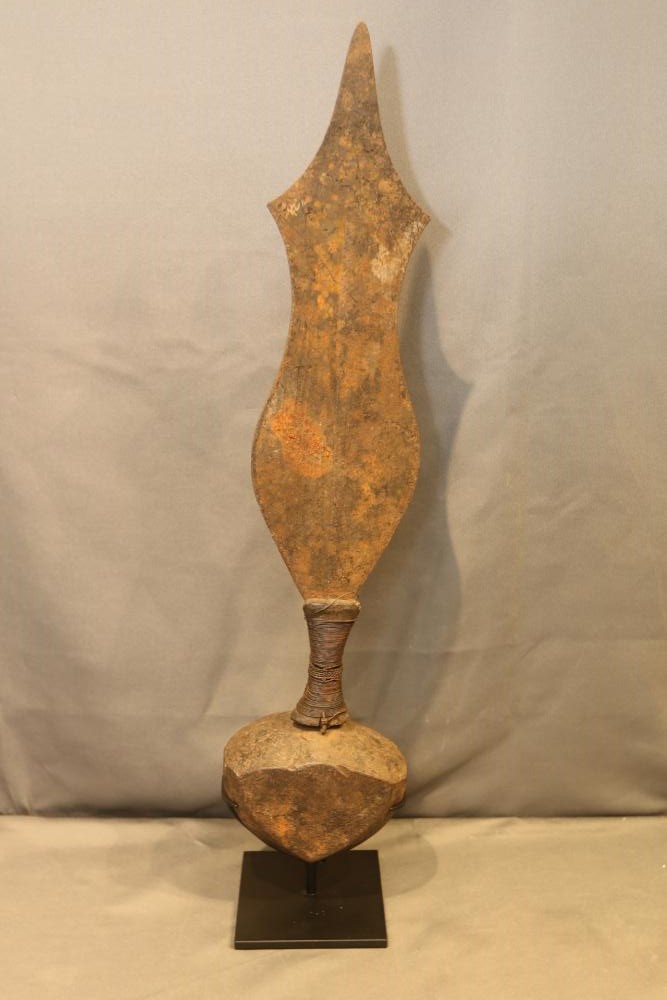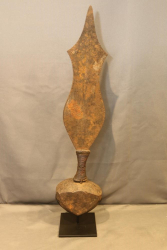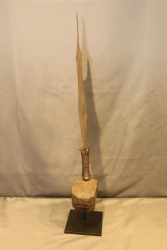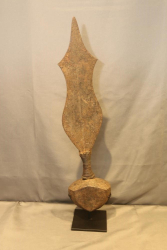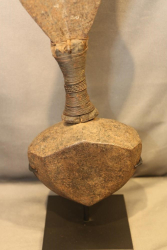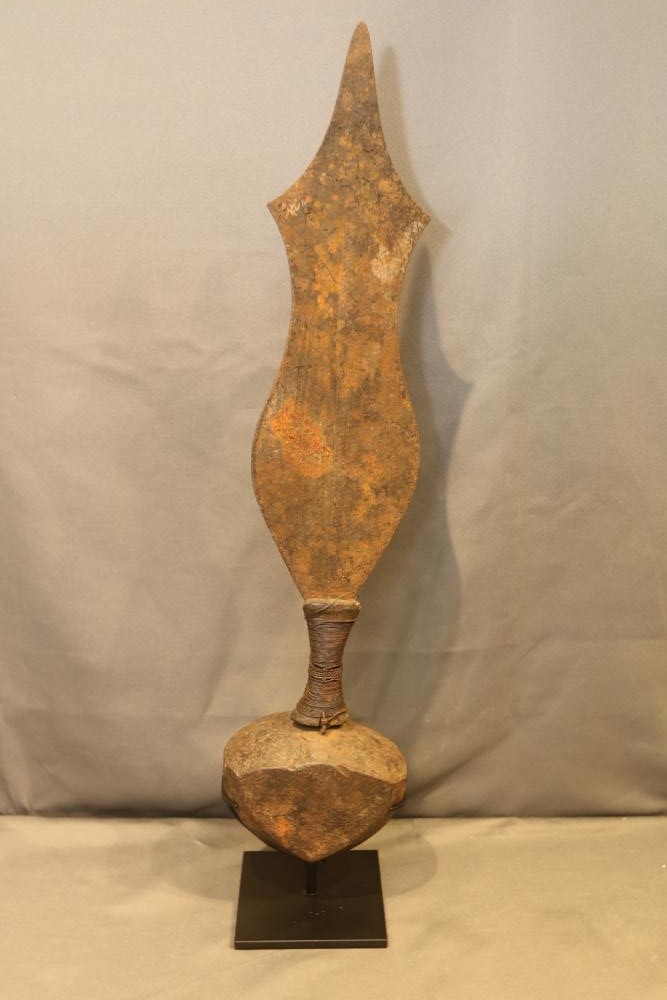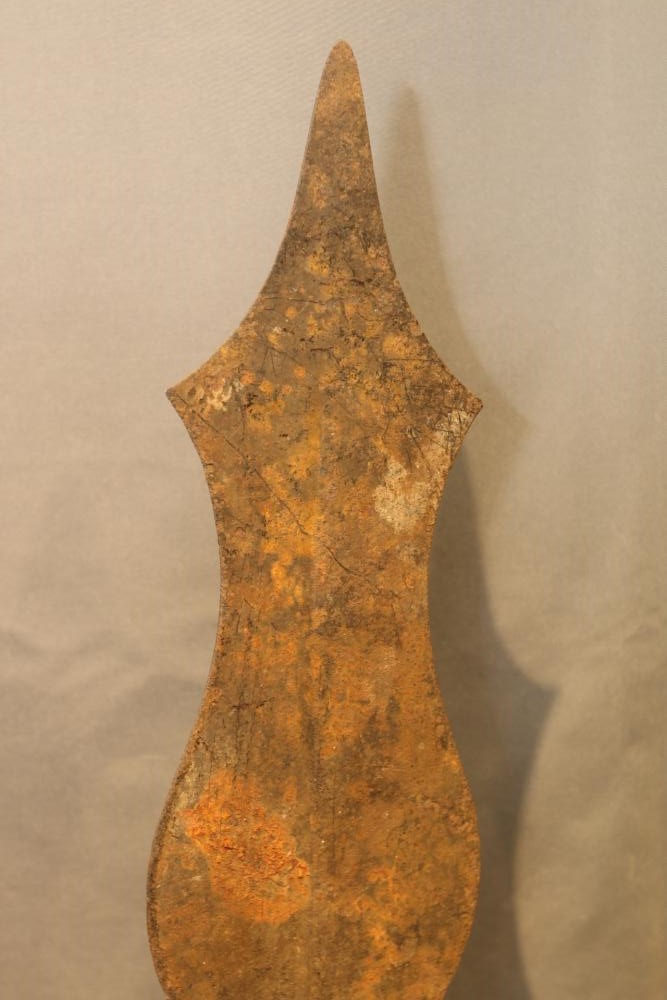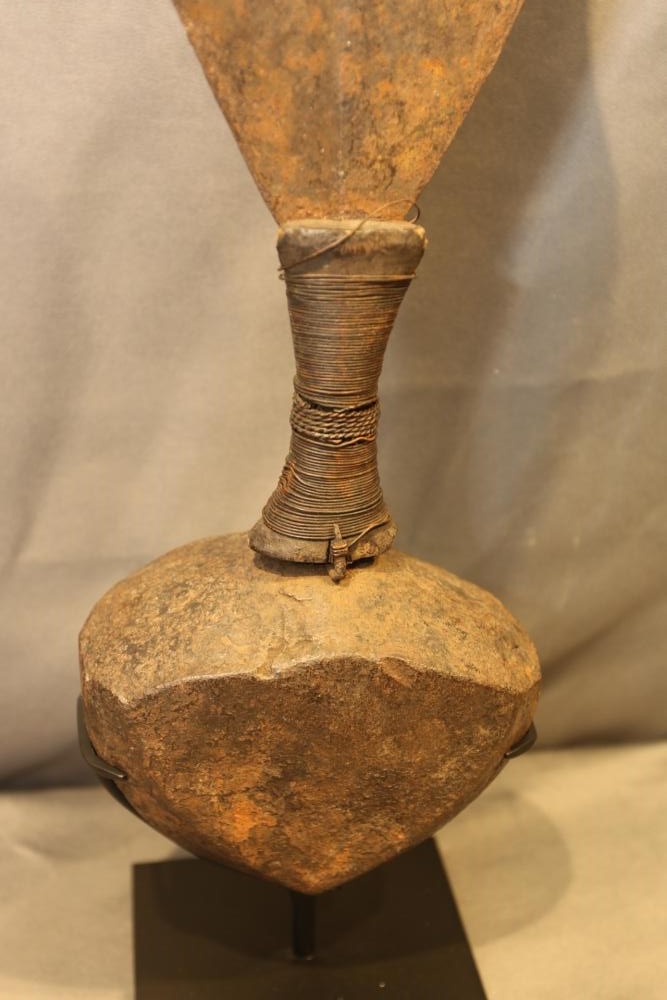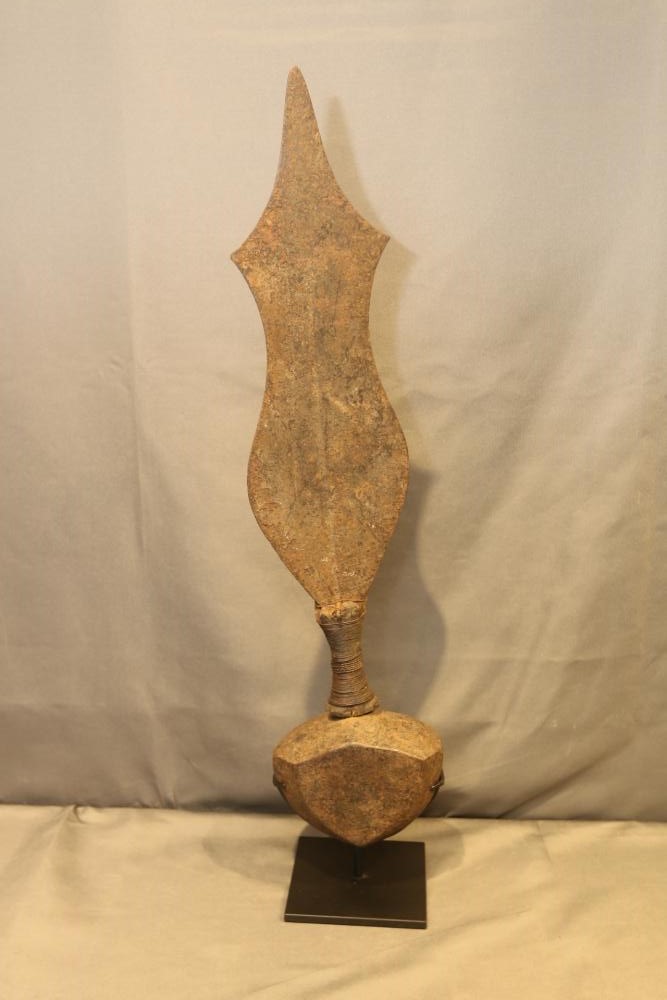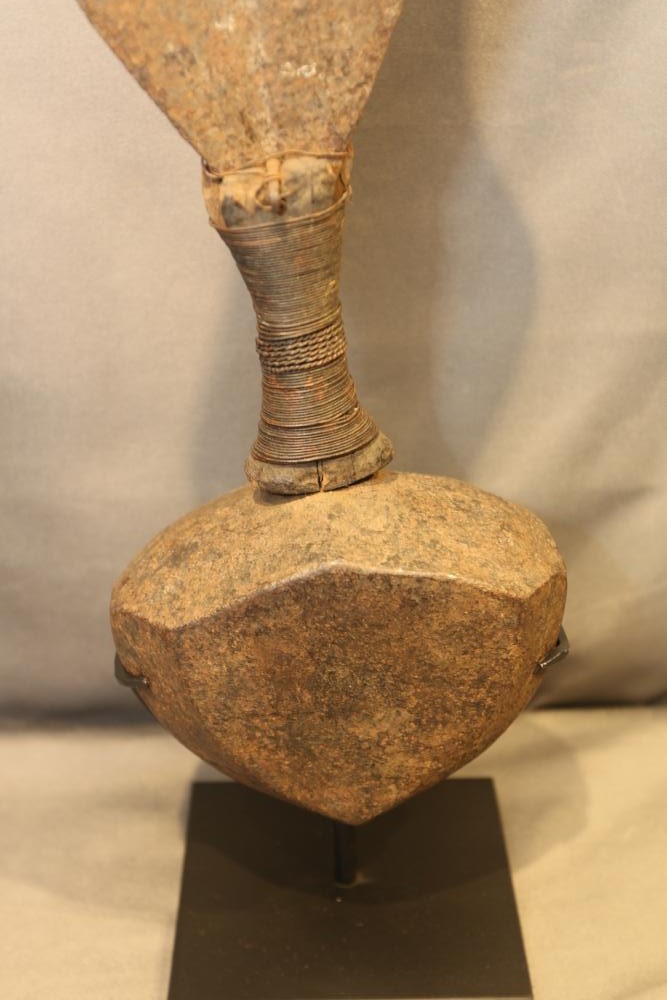Items located in Pleasant Valley, NY. Items include Liganda spear currency Topoke or Eso people, Congo; F-form throwing blades. (A) Laka people, Cameroon; throwing knife. Mbanza people, Democratic Republic of Congo; currency throwing knife. Fulani people, Cameroon or Nigeria; long sickle-shaped weapon. Ngombe people, Congo; ceremonial execution sword. Tikar people, Cameroon; exceptional Chief's prestie parade ax (Kilanda). Songye people, Congo; slashing knife. Konda or Mongo people, Congo; slashing knife. Konda or Mongo people, Congo and more.
AFRICAN ART COLLECTION OF MARY SUE AND PAUL PETER ROSEN
Mary Sue and Paul Peter Rosen have collected African art for over thirty years, making nine trips to Africa to study the art in its cultural setting. The Rosens have published three African art books, curated more than ten exhibitions from their collection, and have given public lectures about African art and culture. They have donated art from their collection to various institutions including the Newark Museum, Temple University in Philadelphia, the SMA Fathers African Art Museum in Tenafly, New Jersey, and the African American Research Library in Fort Lauderdale, Florida.
Payment is due by Monday, December 9 at 1PM. **NOTE: We will be closing at 11AM on Friday, December 6th for our Company Holiday Party.
Pickup in Pleasant Valley, NY must be completed by Monday, December 9 at 3PM.
All lots sold as is, where is. There is a 15% Buyers Premium for all lots purchased. Payment methods include cash, MC, Visa, Discover or good check. You can make credit card payment online by going to your Member Area and selecting your invoice.
*NOTE* Shipping is available on all items.
AFRICAN ART COLLECTION OF MARY SUE AND PAUL PETER ROSEN
Mary Sue and Paul Peter Rosen have collected African art for over thirty years, making nine trips to Africa to study the art in its cultural setting. The Rosens have published three African art books, curated more than ten exhibitions from their collection, and have given public lectures about African art and culture. They have donated art from their collection to various institutions including the Newark Museum, Temple University in Philadelphia, the SMA Fathers African Art Museum in Tenafly, New Jersey, and the African American Research Library in Fort Lauderdale, Florida.
Payment is due by Monday, December 9 at 1PM. **NOTE: We will be closing at 11AM on Friday, December 6th for our Company Holiday Party.
Pickup in Pleasant Valley, NY must be completed by Monday, December 9 at 3PM.
All lots sold as is, where is. There is a 15% Buyers Premium for all lots purchased. Payment methods include cash, MC, Visa, Discover or good check. You can make credit card payment online by going to your Member Area and selecting your invoice.
*NOTE* Shipping is available on all items.
Auction Info
Items located in Pleasant Valley, NY. Items include Liganda spear currency Topoke or Eso people, Congo; F-form throwing blades. (A) Laka people, Cameroon; throwing knife. Mbanza people, Democratic Republic of Congo; currency throwing knife. Fulani people, Cameroon or Nigeria; long sickle-shaped weapon. Ngombe people, Congo; ceremonial execution sword. Tikar people, Cameroon; exceptional Chief's prestie parade ax (Kilanda). Songye people, Congo; slashing knife. Konda or Mongo people, Congo; slashing knife. Konda or Mongo people, Congo and more.
AFRICAN ART COLLECTION OF MARY SUE AND PAUL PETER ROSEN
Mary Sue and Paul Peter Rosen have collected African art for over thirty years, making nine trips to Africa to study the art in its cultural setting. The Rosens have published three African art books, curated more than ten exhibitions from their collection, and have given public lectures about African art and culture. They have donated art from their collection to various institutions including the Newark Museum, Temple University in Philadelphia, the SMA Fathers African Art Museum in Tenafly, New Jersey, and the African American Research Library in Fort Lauderdale, Florida.
Payment is due by Monday, December 9 at 1PM. **NOTE: We will be closing at 11AM on Friday, December 6th for our Company Holiday Party.
Pickup in Pleasant Valley, NY must be completed by Monday, December 9 at 3PM.
All lots sold as is, where is. There is a 15% Buyers Premium for all lots purchased. Payment methods include cash, MC, Visa, Discover or good check. You can make credit card payment online by going to your Member Area and selecting your invoice.
*NOTE* Shipping is available on all items.
AFRICAN ART COLLECTION OF MARY SUE AND PAUL PETER ROSEN
Mary Sue and Paul Peter Rosen have collected African art for over thirty years, making nine trips to Africa to study the art in its cultural setting. The Rosens have published three African art books, curated more than ten exhibitions from their collection, and have given public lectures about African art and culture. They have donated art from their collection to various institutions including the Newark Museum, Temple University in Philadelphia, the SMA Fathers African Art Museum in Tenafly, New Jersey, and the African American Research Library in Fort Lauderdale, Florida.
Payment is due by Monday, December 9 at 1PM. **NOTE: We will be closing at 11AM on Friday, December 6th for our Company Holiday Party.
Pickup in Pleasant Valley, NY must be completed by Monday, December 9 at 3PM.
All lots sold as is, where is. There is a 15% Buyers Premium for all lots purchased. Payment methods include cash, MC, Visa, Discover or good check. You can make credit card payment online by going to your Member Area and selecting your invoice.
*NOTE* Shipping is available on all items.
Categories:
Previous
|
EXCEPTIONAL ?STANLEY POOL? KNIFE. Tetela and Mbole people, Congo. Although it was once thought that these knifes originated in the Stanley Pool area where they were first encountered by European explorers, it is now believed that they were introduced farther to the north. The unusual feature is a large, heavy solid iron butt or pommel. There has been considerable speculation about how a knife with such a heavy butt was used. A widely held theory is that the knife was dropped butt first to stun an enemy by a warrior hidden in a tree along a forest trail. The warrior would then descend quickly and stab the incapacitated enemy with the knife. While this might be possible, it would require exceptional coordination and aim. It is more likely that prestige was attached to the size and weight of the pommel. The blade is embedded in a wooden shaft that is wrapped in copper wire and stuck into the iron pommel. Overall weight is 8lb, with most of the weight in the pommel. H 21.25in.
More Details
EXCEPTIONAL ?STANLEY POOL? KNIFE. Tetela and Mbole people, Congo. Although it was once thought that these knifes originated in the Stanley Pool area where they were first encountered by European explorers, it is now believed that they were introduced farther to the north. The unusual feature is a large, heavy solid iron butt or pommel. There has been considerable speculation about how a knife with such a heavy butt was used. A widely held theory is that the knife was dropped butt first to stun an enemy by a warrior hidden in a tree along a forest trail. The warrior would then descend quickly and stab the incapacitated enemy with the knife. While this might be possible, it would require exceptional coordination and aim. It is more likely that prestige was attached to the size and weight of the pommel. The blade is embedded in a wooden shaft that is wrapped in copper wire and stuck into the iron pommel. Overall weight is 8lb, with most of the weight in the pommel. H 21.25in.
High Bid:
$90.00 – jpant230
Auction Type: One Lot
Quantity: 1
Bidding has closed on this lot

